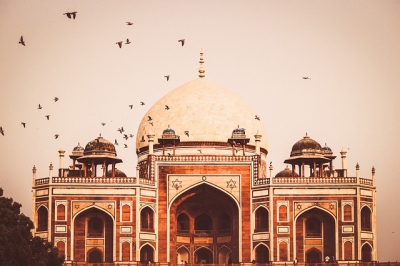
Humayun’s Tomb, situated in Delhi, is the grand mausoleum of the Mughal emperor Humayun. Built in 1570, Humayun’s Tomb is situated in a complex spanning 27 hectares that also houses other monuments such as Nila Gumbad, Isa Khan’s tomb, Bu Halima, Afsanwala tomb complex, Barber’s Tomb, and the Arab Serai, the complex where the craftsmen employed in the construction of Humayun’s Tomb stayed.
1. Commissioned by a queen
Humayun’s Tomb was commissioned by his wife. Haji Begum post the Mughal emperor’s demise. It is said she called for architects from Persia and asked them to build something spectacular that the world would remember. The tomb was designed by Mirak Mirza Ghiyas and his son, Sayyid Muhammad. Emperor Akbar, the son of Humayun, oversaw the entire project
2. The first garden tomb
The monument is the first garden tomb to be built in the Indian subcontinent. It is an example of the charbagh style, a four quadrant garden with the four rivers of Quranic paradise represented by waterways. The main tomb is located in the centre of the charbagh. The four quadrants are further divided into smaller squares by pathways, leaving us with 36 squares in all. This 36-square design is typical of later Mughal gardens.
3. An unique combination
Humayun’s Tomb is the first monument to use the unique combination of red sandstone and white marble. While the tomb is made of rubble masonry and red sandstone, white marble has been used as cladding material to provide a degree of thermal insulation and weather resistance. It has also been used for the flooring, door frames, lattice screens/jaalis (a screen made of perforated stone usually in an ornamental pattern), eaves and the main dome.
4. Dormitory of the Mughals
It might be called Humayun’s Tomb, but the monument is often referred to as the ‘dormitory of the Mughals’, as over 150 graves of Mughal family members can be found buried in the cells of the garden-tomb. Since the graves are not scripted, it is difficult to know the names of the people buried there.
5. Inspiration for the Taj
Humayun’s Tomb was the first of the many dynastic mausoleums which became synonymous with Mughal architecture. It inspired several major architectural innovations by the Mughals and culminated with the construction of the Taj Mahal in Agra by Shah Jahan, who drew inspiration from the architecture and design of Humayun’s Tomb.
Picture Credit : Google




